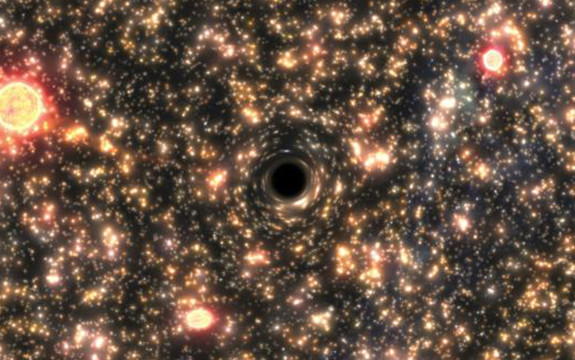Black holes follow the rules

In Summary
Rather than having random sizes, massive black holes seem to follow a predictable rule in relation to the physical properties of the galaxy in which they are located.
Research at Swinburne University of Technology has shown that it is possible to predict the masses of black holes in galaxies for which it was previously thought not possible.
In large galaxies, the central black hole is related to the mass of the spheroid-shaped distribution of stars at the centre of the galaxy, known as the galaxy’s 'bulge'.
Some astronomers have claimed that the size of black holes at the centres of galaxies with small bulges was unrelated to the bulge.
Even the four million solar mass black hole in the bulge of our Milky Way galaxy was thought to be arbitrarily low relative to trends defined by their more massive, and therefore easier to detect, counterparts.
However, in previous work Swinburne Professor Alister Graham, lead-author of the current research, identified a new relationship involving black holes in galaxies with small bulges. He demonstrated that the black hole in the bulge of the Milky Way was not set by chance but instead followed an astronomical rule.
“The formula is quadratic, in that the black hole mass quadruples every time the bulge mass doubles,” Professor Graham said. “Therefore, if the bulge mass increases 10 times, the black hole mass increases 100 times.”
Now, after studying more than 100 galaxies with black holes 4 to 40 times less massive than our Milky Way's black hole, they too have been found to follow this same rule.
"It turns out that there is yet more order in our Universe than previously appreciated,” Professor Graham said.
"This is exciting not just because it provides further insight into the mechanics of black hole formation, but because of the predictions it allows us to make."
The gravitational collapse of massive stars can produce black holes up to a few tens of times the mass of our Sun. And black holes that are one-tenth of a million to ten billion times the mass of our Sun have been identified at the centres of giant galaxies. However, there is a missing population of intermediate-mass black holes.
Astronomers don't know if this is because of observational difficulties in finding them, or if the massive black holes at the centres of galaxies start life as 100,000 solar mass seed black holes that formed in the early Universe.
This latest result, which extends the new rule to 40-times lower masses, gives astronomers some confidence that it may extend even further, so the smallest bulges might host these missing intermediate-mass black holes.
"If confirmed, it would imply tremendous black hole appetites", co-author of the study, Dr Nicholas Scott, said. "There would need to be a dramatic growth of these small black holes relative to their host bulge, with the bulges growing via the creation of stars out of gas clouds while the black holes devour both gas and stars."
The researchers have identified a few dozen candidate galaxies in which they think intermediate-mass black holes may be hiding. Future observations, with facilities such as the Square Kilometre Array and space-based X-ray telescopes, are expected to help resolve this black hole mystery.
This research was funded by the Australian Research Council. The study has been published in the Astrophysical Journal.

